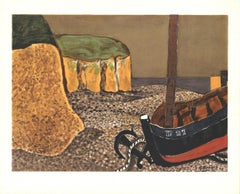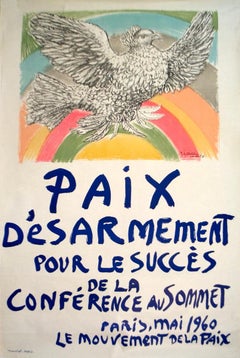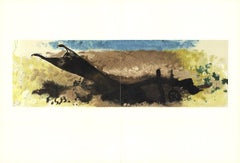Want more images or videos?
Request additional images or videos from the seller
1 of 5
After Marc Chagall 'Lithographe III' 19741974
1974
$400List Price
About the Item
- Creation Year:1974
- Dimensions:Height: 13.5 in (34.29 cm)Width: 20.5 in (52.07 cm)Depth: 0.1 in (2.54 mm)
- Medium:
- Movement & Style:
- After:Marc Chagall (1887 - 1985, French)
- Period:
- Framing:Framing Options Available
- Condition:All items are carefully stored. Condition is a main concern, unless otherwise indicated, all items are in mint condition. Additional pictures are available upon request. Feel free to contact our team if you have any questions or concerns. Thank you.
- Gallery Location:Brooklyn, NY
- Reference Number:Seller: XX38281stDibs: LU1294114524632
About the Seller
4.9
Platinum Seller
Premium sellers with a 4.7+ rating and 24-hour response times
Established in 1992
1stDibs seller since 2019
2,767 sales on 1stDibs
Typical response time: 1 hour
Authenticity Guarantee
In the unlikely event there’s an issue with an item’s authenticity, contact us within 1 year for a full refund. DetailsMoney-Back Guarantee
If your item is not as described, is damaged in transit, or does not arrive, contact us within 7 days for a full refund. Details24-Hour Cancellation
You have a 24-hour grace period in which to reconsider your purchase, with no questions asked.Vetted Professional Sellers
Our world-class sellers must adhere to strict standards for service and quality, maintaining the integrity of our listings.Price-Match Guarantee
If you find that a seller listed the same item for a lower price elsewhere, we’ll match it.Trusted Global Delivery
Our best-in-class carrier network provides specialized shipping options worldwide, including custom delivery.You May Also Like
Prodigal Son
By Thomas Hart Benton
Located in London, GB
A man raises his hand to his chin, his neck tilted and face turned to look at a dilapidated farmhouse, barely held together by planks of wood and exposed to the elements. Behind him ...
Category
1930s American Modern Landscape Prints
Materials
Lithograph
Nebraska Evening
By Thomas Hart Benton
Located in London, GB
A fine impression with good margins published by Associated American Artists.
Category
1940s American Modern Landscape Prints
Materials
Lithograph
Discussion
By Thomas Hart Benton
Located in London, GB
In this charming regionalist lithograph, Benton captures a classic Midwestern American scene: two men talking, drinking, and smoking together in a bar. Titled 'Discussion', the artwo...
Category
1930s American Modern Figurative Prints
Materials
Lithograph
Old Man Reading
By Thomas Hart Benton
Located in London, GB
Accompanied by a lantern, an elderly man sits alone, engrossed in a newspaper. Benton used a lithographic process to draw and produce this image. He renders the face and paper well-l...
Category
1940s American Modern Figurative Prints
Materials
Lithograph
Haystack
By Thomas Hart Benton
Located in London, GB
A fine impression of this very popular image with full margins (smaller on top and bottom) published by Associated American Artists.
Category
1930s American Modern Landscape Prints
Materials
Lithograph
Down the River
By Thomas Hart Benton
Located in London, GB
In this sentimental work from 1939, Benton expresses his admiration for the rural lifestyle of the Midwest. He highlights the connection between man and the land by depicting two fig...
Category
1930s American Modern Figurative Prints
Materials
Lithograph
Théo Tobiasse "Cantate 51 de Bach" Signed 1979 Lithograph, Music & Memory Theme
By Théo Tobiasse
Located in Miami, FL
THÉO TOBIASSE – "CANTATE 51 DE BACH POUR LES JOURS DE LUMIÈRE"
⚜ Lithograph on paper ⚜ Hand signed and numbered ⚜ Conservation framed
SYMPHONIC FIGURATION FROM TOBIASSE’S FEMME SERI...
Category
1970s Modern Figurative Prints
Materials
Lithograph
$3,800
H 49.75 in W 36.375 in D 1.5 in
Italian 1980s Ugo Attardi Signed Work on Paper Nude of Woman
By Ugo Attardi
Located in Roma, IT
Italian 1980s Ugo Attardi Signed Work on Paper Nude of Woman
A beautiful "Prova d'Artista" Pop Art-inspired graphic work by one of Italy's greatest modern artists, Ugo Attardi.
It d...
Category
Late 20th Century Modern Nude Prints
Materials
Lithograph
$1,912
H 32.88 in W 39.77 in D 2.76 in
1950s Italian Signed Lithograph by Francesco Messina
By Francesco Messina
Located in Roma, IT
Beautiful lithograph by the great postwar Italian artist Francesco Messina.
Depicts in a beautiful pose a nude of a woman "Lying Model"
Very rare "Artist's Proof Hors Commerce" wit...
Category
Mid-20th Century Modern Nude Prints
Materials
Lithograph
$836
H 1.19 in W 24.41 in D 19.3 in
La Bouquetiere 1957
By Georges Lambert
Located in Belgrade, MT
Georges Lambert ( French, 1919-1998) was a French painter and lithographer devoted to vibrant coloration of landscapes, figure studies, seascapes, and harbor scenes, in a semi modern...
Category
Mid-20th Century Modern Figurative Prints
Materials
Lithograph
More From This Seller
View AllBraque La Barque DLM27 Vintage Mid Century lithograph
By (after) Georges Braque
Located in Brooklyn, NY
This lithograph titled La Barque (The Boat) by Georges Braque is a reproduction from the 1960 edition of Derrière le Miroir (DLM) #27. Printed by Arte in Paris, this piece is recreat...
Category
20th Century Modern Landscape Prints
Materials
Lithograph
Camille Portrait
By (after) Georges Rouault
Located in Brooklyn, NY
This lithograph, titled Portrait of Camille, is a significant work by the French Fauvist artist Georges Rouault. Executed with precision by lithographer Daniel Jacomet, this print is...
Category
Late 20th Century Modern Portrait Prints
Materials
Lithograph
$320 Sale Price
20% Off
Paix Disarmement-Peace-POSTER LITHOGRAPH
By Pablo Picasso
Located in Brooklyn, NY
Paper Size: 47 x 31.5 inches ( 119.38 x 80.01 cm )
Image Size: 19 x 25.5 inches ( 48.26 x 64.77 cm )
Framed: No
Condition: A-: Near Mint, very light signs of handling
Additional Det...
Category
20th Century Modern Prints and Multiples
Materials
Lithograph
$2,000 Sale Price
20% Off
Georges Braque 'Bord de Mer'
By Georges Braque
Located in Brooklyn, NY
This original lithograph by Georges Braque, titled Bord de Mer (Seashore), was published by Maeght in 1960 as part of the Derriere le Miroir series. The double page lithograph featur...
Category
1960s Modern Prints and Multiples
Materials
Lithograph
$240 Sale Price
52% Off
Lithographies chez Maeght Zurich
By (after) Georges Braque
Located in Brooklyn, NY
This original poster was created for a Georges Braque exhibition at the Maeght Gallery in Zurich. The artwork prominently features two birds in flight, with one outlined in white and...
Category
Late 20th Century Modern Abstract Prints
Materials
Lithograph
$72 Sale Price
20% Off
Le Petite Plage, lithograph
By Bernard Buffet
Located in Brooklyn, NY
Printed as one of 11 lithographs included in the 1967 publication "Bernard Buffet: Lithographs 1952- 1966." Produced in cooperation with Fernand Mourlot, this was a catalogue of all ...
Category
Mid-20th Century Modern Portrait Prints
Materials
Lithograph
$496 Sale Price
20% Off



